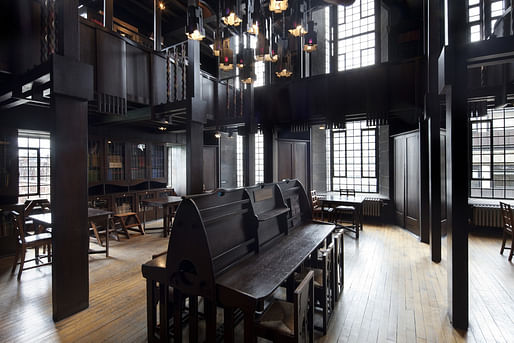
In May 2014, as students prepared their final-year degree show, the Mackintosh Building that houses The Glasgow School of Art was engulfed by flames and severely damaged. The building, built between 1897-1909, is one of the Scottish city's most famous structures. It is considered the architect Charles Rennie Mackintosh's ultimate masterwork and in 2009, was awarded RIBA's "Sterling of Sterlings prize" when chosen, through a nationwide poll, as the best British-designed building of the past 175 years. About 90% of the historic building was spared by the fire but the library, one of the finest examples of art nouveau design, as well as the Japanese-inspired Studio 58 were almost entirely destroyed.

Soon after, a careful restoration plan began headed by the Glasgow-based firm, Page\Park architects. Work on the building has been in constant progress since the summer of 2014, beginning with debris removal and followed by the painstaking salvage process and a diligent drying out of the structure to prevent future incidents. The team has gone to painstaking lengths to ensure historical accuracy. The project has called on the help of up to 30 different trades and craftspeople, from horse hair plasterers to lead glaziers, and no detail has been overlooked. A team of forensic archeologists were even employed to rescue 620 individual pieces of brass plate lamp fittings, in order to recreate 29 out of the 48 original light fittings.


A full restoration of the roof is also underway and involved the sourcing of wood all the way from Massachusetts. The original wooden uprights in the famed Studio 58 had been made from an American yellow pine that comes from Massachusetts. By fortunate happenstance, when the contractors began searching for a replacement, they learned that the historic Picker Building, a part of the Massachusetts Cotton Mills complex, was being demolished. Also built at the turn of the 20th century, the Picker Building used the same quality yellow pine in the size needed for proper restoration. Eight 13-1/2 inch x 15-1/2 inch x 23 foot beams were loaded into a shipping container and sent across the Atlantic to land in Scotland where the four massive replacement uprights were tested, shaped and craned into place, thus cementing the relationship between Glasgow and Massachusetts that began over a century ago when the two buildings were constructed.
No Comments
Block this user
Are you sure you want to block this user and hide all related comments throughout the site?
Archinect
This is your first comment on Archinect. Your comment will be visible once approved.